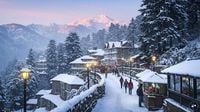In a significant gesture of inclusivity and grassroots engagement, Himachal Pradesh Chief Minister Sukhvinder Singh Sukhu visited the remote Pangi Valley in Chamba district on Monday, unveiling a slew of development projects worth crores. This visit comes ahead of Himachal Day 2025, which will be celebrated in Killar, the valley’s headquarters—a first in the state’s history.
During his address, CM Sukhu emphasized that the development of tribal regions like Pangi remains among the top priorities of the state government, signaling a focused shift towards bridging rural-urban developmental disparities. "The all-round development of Himachal, including tribal areas, is our mission. We are not just making announcements but ensuring implementation," said Sukhu.
This year, Himachal Day will be marked in Pangi Valley on April 15, underlining the government’s commitment to bringing remote regions into the mainstream developmental narrative. Traditionally held in urban or centrally located towns, the decision to celebrate in Pangi reflects a dedication to inclusivity.
CM Sukhu’s visit was not merely symbolic; it was packed with a major developmental push for Pangi and surrounding tribal belts. Key projects announced include ₹25 lakh each for women’s community centres in Dharwas and Lunj, ₹10 lakh for completing an additional centre in Lunj, and ₹1 lakh each for equipment procurement at three community centres. Other significant investments include ₹3.75 crore for agriculture department quarters in Killar, ₹1.5 crore each for additional classrooms at Govt Senior Secondary Schools in Lunj and Mindhal, ₹2.13 crore for a sub-market yard in Killar, ₹49.42 lakh for a new HPSEBL office building, and ₹1.99 crore each for health sub-centres in Rei and Hudan.
These announcements reflect a holistic approach—investing in education, women empowerment, infrastructure, health, and agriculture. One of the most ambitious announcements made during the visit was the interest subsidy scheme for solar energy projects. The details of the solar subsidy include a 5% interest subsidy on projects between 250 KW to 1 MW in tribal areas, 4% in non-tribal regions, and 3% for projects above 1 MW. "We are encouraging solar projects on private lands. Clean energy must be part of our developmental mission," Sukhu emphasized. This initiative aligns with the state’s vision of becoming carbon neutral and a leader in green energy solutions, especially in areas like Pangi that have ample sunlight and open terrain.
Reassuring tribal communities, CM Sukhu stated that the state government’s doors remain open to all opportunities that can improve the quality of life in tribal belts. "I assure prompt redressal of all issues and a proactive role in uplifting every section of society," he told reporters. He further underlined that there is no shortage of funds for genuine developmental work and that every rupee will be spent with accountability and transparency.
Locals in Pangi Valley have welcomed this historic move. For a region that has remained on the fringes due to geographical isolation, celebrating Himachal Day 2025 in Killar is not just symbolic—it is a message of inclusivity and recognition. "This is the first time a Chief Minister has brought such attention and direct investment to our valley," said a local community leader in Lunj.
Sukhu’s tribal development mission is being seen as a strategic pivot for the Congress-led government ahead of next year’s state polls. By focusing on remote districts like Pangi, the government not only promotes equity but also builds deeper voter engagement in regions that have historically lacked visibility.
As Himachal Day 2025 approaches, the spotlight is not on Shimla or Dharamshala, but on Killar in Pangi Valley—a decision that reflects the state’s inclusive growth agenda. Chief Minister Sukhvinder Singh Sukhu’s announcements represent more than policy; they signify a shift in governance focus, from statistical development to visible, people-first progress. The hills of Pangi may be remote, but this Himachal Day, they will echo with pride, promise, and the power of democratic development.
Himachal Day is a state holiday celebrated across districts with local fairs, cultural performances, and community events that showcase the state's traditional art, music, crafts, and cuisine. It’s a time when residents pay homage to their roots and look ahead to a brighter future for the region. From the snow-covered peaks of the Dhauladhar to the apple orchards of Kinnaur and the spiritual calm of monasteries in Spiti, Himachal Pradesh is known for its natural beauty, vibrant traditions, and deep-rooted sense of community.
The name “Himachal” comes from the Sanskrit words ‘Hima’ (snow) and ‘Anchal’ (lap), meaning "in the lap of snow." The state's economy is largely supported by agriculture and tourism, and it proudly houses unique attractions such as the world’s highest cricket ground in Chail and the ecologically diverse Great Himalayan National Park, a UNESCO World Heritage Site.
In a landmark decision, the official Himachal Day celebration for 2025 will take place in Pangi Valley, one of the most remote regions in the state, located in Chamba district. The celebrations will be held at Killar, the valley's headquarters, on April 15. This marks the first time the state-level event is being hosted in Pangi Valley—a move that highlights the state government’s focus on inclusive development and the welfare of tribal and remote areas. Last year, the celebration was held in Kaza, Spiti Valley, and the Chief Minister's direct engagement with the locals was widely appreciated.
As the date draws closer, the sentiment among locals is one of pride and anticipation. Celebrating Himachal Day in Killar is expected to bring attention to the unique challenges faced by the Pangi Valley residents while showcasing the government's commitment to addressing these issues. In this context, Himachal Day 2025 is not just an event; it is a pivotal moment for the state's tribal communities, reflecting a promise of development and recognition.







